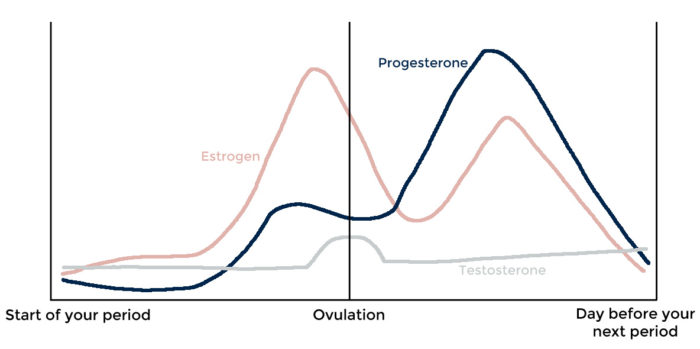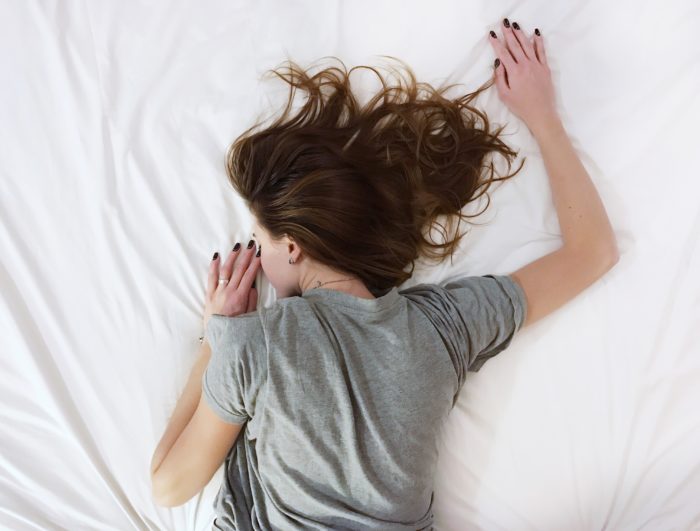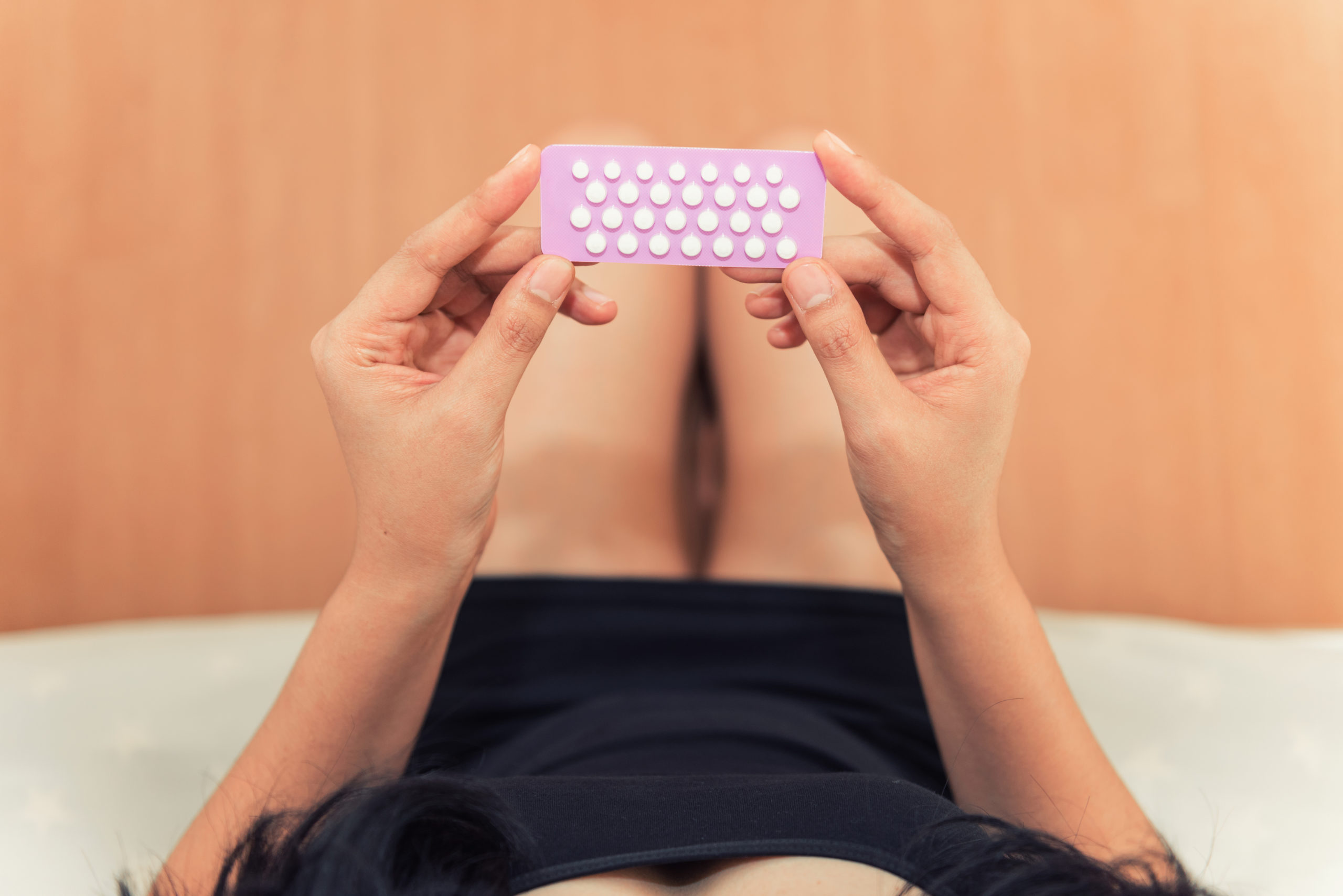Hormonal birth control (or “The Pill”) works by suppressing your natural hormone production. And while this can be effective for preventing pregnancy, it can have negative effects on your own hormone health.
There are some situations, like severe endometriosis and dangerously heavy menstrual bleeding, that do benefit from using The Pill. Not all hormonal birth control use is unnecessary.
However, many women use this form of birth control to mask hormonal symptoms, without ever truly understanding its potential side effects.
We women have a delicate balance of ever-fluctuating hormones that keep our bodies perfectly in rhythm. From our menstrual cycles to our sleep-wake cycles, our bodies are on a very precise internal clock.
And any outside influence, whether it be a stressful event or the use of hormonal birth control, can disrupt that delicate balance.
This is why introducing synthetic hormones via The Pill causes women so many unwanted side effects.
Side effects of using hormonal birth control be as mild as spotting between periods, and as serious as blood clots.
In this post, I’ll focus on the effects long-term birth control use can have on your hormone health.
If you’re interested in learning about some of the other risks of using hormonal birth control, check out this article I wrote.
The Pill and Our Hormones
Our body’s hormonal balance is so much more complex than the sex hormones that you typically think of.
Unfortunately, the negative effects The Pill has on our hormones don’t just stop at estrogen and progesterone.
The Pill has wide-reaching effects that can affect the health of our entire endocrine system.
If you’ve ever been on The Pill, are currently on The Pill, or are thinking you might eventually want to start using hormonal birth control, keep reading!
In this blog post you’ll learn:
- What makes up a healthy menstrual cycle
- What happens to your hormones when you’re on The Pill
- Side effects of those hormonal changes
- How to reduce these side effects if you need to be on The Pill
- My preferred alternative to hormonal birth control
What a Normal Menstrual Cycle Looks Like
To help you better understand the effects that The Pill has on your hormones, we’re going to do a deep dive into what a normal menstrual cycle looks like.
Learning about what actually goes on behind the scenes of our periods is incredibly empowering. It allows us to flip the script about what a period really means.
Instead of our period just being something that happens to us, we can take ownership of that critical piece of being a woman.
Phase 1: The Follicular Phase
When we’re not on hormonal birth control, a normal menstrual cycle consists of two distinct phases.
The first part of our cycle, from the day you start your period to when you ovulate, is known as the follicular phase.
The follicular phase, as the name suggests, is when your body prepares to release an egg by forming a follicle. The release of an egg (ovulation) signals the end of this phase of our cycle.
This portion of our cycle can vary greatly in length from woman to woman, and even from cycle to cycle in the same woman. Typically, the follicular phase ranges anywhere from 11 to 27 days. But ideally, your follicular phase should be around 14-21 days.
FYI: Issues like stress, PCOS, and low Vitamin D levels are just a few reasons why this phase of your cycle could last longer than expected.
PHase 2: The Luteal Phase
The second part of our cycle, from ovulation until the day before your next period is the luteal phase.
This part of your cycle is all about preparing your body for pregnancy if the egg released during ovulation does get fertilized. If fertilization doesn’t occur, the uterine lining that was built up throughout your cycle starts to shed, resulting in your period.
The luteal phase is typically going to be the same length, give or take a day or two, for each woman. The average length of this phase is around 10 to 16 days. Ideally, it should be as close to 14 days as possible. Less than 10 days is considered a “short luteal phase” or a “luteal phase defect”.
FYI: A short luteal phase is usually caused by the body not producing enough progesterone. Often times this is because of a lack of ovulation, or an “anovulatory” cycle.

Hormone Fluctuations During Our Cycle
Our sex hormones fluctuate in a way that distinguishes each phase in our cycle.
High estrogen levels dominate the follicular phase. And after ovulation, estrogen levels fall rapidly, leaving progesterone as the main hormone at play during the luteal phase.
If fertilization didn’t occur, both hormones start their decline, bottoming out at the start of your next period. This decline in both hormones is what leads our uterine lining to shed. (Voila, a period!)
Graphs like the one below help us understand the fluctuations of our hormones during the menstrual cycle.

As you can see, there’s a lot going on behind the scenes when it comes to our period. Estrogen and progesterone are in a synchronized dance that dictates our fertility for that cycle.
When these hormones are thrown off, or suppressed like with hormonal birth control use, we may start to notice negative effects.

Your Hormones on The Pill
Hormonal birth control stops your hormone cycle.
When you’re using birth control methods like The Pill, your body no longer follows the natural hormonal rhythms of a normal menstrual cycle.
We no longer have a follicular phase or a luteal phase, or even a real period. We just have a phase of consistent synthetic hormones and then a withdrawal bleed once a month that simulates a real period.
The Pill basically tricks your body into thinking that you’re pregnant.
It does this by suppressing the hormone released by your pituitary, gonadotropin-releasing hormone (GnRH). This is the hormone that tells your ovaries it’s time to ovulate. The suppression of GnRH that occurs with Pill use is similar to what happens during pregnancy.
So those hormonal fluctuations that we just described simply won’t occur.
Also, The Pill provides your body with plenty of estrogen and progesterone, albeit the synthetic versions. Your body gets the signal that it has enough hormones and doesn’t need to make any of its own.
The Pill Does Not Balance yOur Hormones
Anyone who has told you that The Pill can help balance your hormones was wrong.
The truth is, The Pill doesn’t balance our natural hormones. It tells our bodies not to make them.
This isn’t an ideal situation for women who have been blindly prescribed the pill to “fix” their period problems.
Remember, there are some situations in which using hormonal birth control is necessary. Women with severe endometriosis or debilitating PMS often find great symptom relief from using The Pill. There’s no shame in using hormonal birth control if you’re experiencing a serious disruption in your life from hormone-related health issues.
However, more often than not, doctors are prescribing hormonal birth control for even minor hormonal issues without educating their patients about the risks.
Often times The Pill was never necessary to solve the problem it was prescribed for. And in many cases, the negative impact The Pill has on a woman’s hormones heavily outweigh any benefits.
Effects of Hormonal Birth Control on Our Hormones
Any foreign substance, whether it be the synthetic hormones in The Pill or xenoestrogens in skincare, is going to have an impact on our own natural hormone levels.
And when it comes to The Pill, the negative effects to our own hormones reach far beyond just suppressing our sex hormone production.
Let’s review four possible effects that using hormonal birth control can have on our own hormones.

#1: Hypothyroidism
The high levels of estrogen in most forms of hormonal birth control actually do much more than just keep you from getting pregnant. This increase in estrogen acts as a signal for your body to also release more of a substance called Thyroid Hormone Binding Globulin (THBG).
As the name suggests, THBG binds to thyroid hormone. Which makes it unusable by the body, or inactive.
Under normal conditions, THBG transports thyroid hormone from the thyroid gland to your cells. Once it reaches its final destination, the thyroid hormone would unbind and change into its usable form.
However, when there are increased levels of THBG, that thyroid hormone never gets the chance to unbind. It just stays in transport mode, never able to be used.
Your body may be producing thyroid hormone just fine. But the effects of The Pill on your hormonal balance can actually cause you to have low levels of usable thyroid hormone.
Inflammation
The Pill is also inflammatory. And inflammation is behind many health conditions, including some cases of hypothyroidism. (In particular, Hashimoto’s thyroiditis.)
Similarly to the increased levels of THBG, this increase in inflammation prevents the conversion of the inactive thyroid hormone to the active, usable form.
Would you like to save this post?
Your email address is 100% safe and will never be sent spam.
Having low levels of usable thyroid hormone can lead to symptoms of hypothyroidism. This can include fatigue, bloating, weight gain, hair loss, anxiety, and dry skin. Hypothyroidism can even cause miscarriage in the future once hormonal birth control is stopped.

#2: Low Testosterone
Many women start using hormonal birth control to prevent pregnancy and have worry-free sex.
But the irony is that low testosterone levels caused by The Pill can prevent women from even desiring sex once they’re on it!
Testosterone is a primary driver of sexual desire in both women and men (though in MUCH higher quantities in men!) In a normal menstrual cycle, women have relatively constant, low levels of testosterone. Testosterone does peak slightly around ovulation, giving you a spike in libido in the middle of your cycle.
This makes biological sense, since the days leading up to ovulation, and 24 hours after ovulation, is the only time a woman can get pregnant. So desiring sex around that time increases the likelihood of procreating.
However, when you’re using hormonal birth control, your levels of testosterone can drop by as much as 61%!
Hormonal birth control raises levels of sex hormone binding globulin (SHBG). And much like its thyroid hormone counterpart, SHBG binds to sex hormones to facilitate their transport around the body.
SHBG has a high affinity for testosterone. And with the increase in SHBG, a lot of your usable testosterone is now stuck in transport mode, not available for use when you need it.
Low levels of testosterone can result in symptoms like low libido, fatigue, sleep disturbances, weight gain, low muscle mass, decreased sports performance, and decreased sexual satisfaction.

#3: Low Serotonin & Melatonin
When we think of hormonal health, neurotransmitter hormones like serotonin and melatonin usually don’t take center stage. But they play an equally important role in keeping our body balanced as our main sex and thyroid hormones.
Serotonin helps to keep our moods balanced and regulating our appetite. Melatonin is the king of sleep. And without enough of these hormones, you’ll likely have trouble falling or staying asleep.
These two hormones also work together in the body. A process known as methylation converts serotonin to melatonin in the gut. When serotonin levels are low, you’re more likely to also be deficient in melatonin.
Which is, unfortunately, often the case when it comes to hormonal birth control use.
The Pill has been shown to deplete levels of vitamins B12 and B6. Both of these vitamins are important cofactors in the production of serotonin.
Without enough B vitamins, you can’t make enough serotonin. And without enough serotonin, you won’t have enough melatonin. This leaves you more susceptible to feelings of anxiety, fatigue, and depression.
Pill-Related Depression
The connection between hormonal birth control and depression is real. And it goes far deeper than The Pill’s effects on serotonin and melatonin.
One study found that women who used hormonal birth control were 23% more likely to suffer from depression than women who didn’t use The Pill.
Hormonal birth control promotes inflammation, nutrient depletion, and thyroid hormone suppression. All of this can play a role in making you feel moody, depressed, and anxious.
So if you’ve recently started using hormonal birth control and aren’t feeling quite like yourself, trust your intuition that it’s not all in your head.
Hormonal birth control can have significant effects on your mental health and wellbeing. This is often the main factor in women deciding to ditch The Pill and seek alternative contraceptive options.

#4: Estrogen Dominance
Most forms of hormonal birth control work by providing your body a high, consistent dose of synthetic estrogen and progesterone.
If you remember from earlier, our natural cycle involves cyclical dips and rises of these two hormones. Our bodies aren’t meant to be subjected to constant levels of these hormones every day of the month.
With elevated levels of The Pill’s synthetic hormones constantly in our bodies, it shouldn’t come as a surprise that estrogen dominance is a common side effect of hormonal birth control use.
Continuously elevated levels of estrogen can overload your liver and it’s ability to detoxify hormones. This actually makes it more difficult to remove this hormone from your body.
When you combine the constant source of estrogen from The Pill with a liver that cannot efficiently remove estrogen, you get a perfect storm for estrogen dominance.
Plus when testosterone is low, as is common with hormonal birth control use, you’re going to inherently experience symptoms associated with estrogen dominance. Even if The Pill didn’t also increase estrogen levels.
Symptoms that typically accompany estrogen dominance are breast tenderness, mood swings, weight gain, and ovarian cysts. These are often the symptoms that women use hormonal birth control to avoid!

Avoiding Hormonal Side Effects of The Pill
For some women, hormonal birth control use truly is the best option. Severe cases of endometriosis and very heavy periods are just two common reasons why The Pill may be helpful. It’s important not to “throw the baby out with the bathwater” when it comes to understanding the risks and benefits of using hormonal birth control.
If you and your doctor do decide that The Pill is best for your unique situation, don’t worry. There are ways you can mitigate these potential hormonal side effects.
These include:
- Supporting your liver. Try eating bitter foods, like dandelion greens and artichoke, or lots of cruciferous vegetables, like broccoli and cauliflower. These foods can help support bile flow and detoxification which enables the liver to better remove those harmful estrogens.
- Supporting your gut. Increase your intake of probiotics and prebiotics to keep your gut healthy and support proper estrogen metabolism. Getting enough fiber and water each day will also help keep your gut moving, providing another elimination pathway for those excess hormones.
- Supporting your thyroid. Including supplements like selenium, iodine, and zinc are all great to support thyroid health while on The Pill. Or, you could include thyroid supportive foods like brazil nuts, seaweed, and shellfish if you don’t want to take a lot of pills. Vitamin A is also crucial for thyroid health.
My Preferred Pill Alternative
When it comes to actual birth control – you know, contraception – I’m a huge fan of the Fertility Awareness Method (or FAM).
The Fertility Awareness Method (NOT the “rhythm” method, by the way) is an effective way to predict fertile and infertile times in your cycle.
FAM is based on body signs, specifically basal body temperature, and cervical mucus, which change during each menstrual cycle in response to the hormones that cause ovulation.
The Fertility Awareness Method can be up to 99% effective if followed correctly.
This means that 1 woman in 100 who use natural family planning will get pregnant in 1 year. There are no hormonal side effects, and you can either use it as a contraceptive method or to plan when you get pregnant.
Here’s a great short overview of FAM and how you can use it to prevent or achieve pregnancy.
And if you want a deeper dive into the intricacies of this birth control method, the book Taking Charge of Your Fertility will be your best guide.
A Simpler Way to Use FAM
If you’re anything like me and monitoring your body temperature and cervical mucus every day seems a little overwhelming, there’s a method to make FAM a little simpler.
That method is the Daysy thermometer!
The Daysy is a fertility tracker that uses the fertility awareness method by learning and tracking your menstrual cycle. The thermometer also has a computer insider to keep track of your data over time.
Daysy tells you when you’re in your fertile window with an accuracy of 99.4%. Your fertility status is displayed either as a red (fertile) or green (not fertile) light. Simply use a barrier method like a condom during the days that you see a red light and you’re good to go!
Keep in mind, the Daysy monitor, and FAM in general, should not be used for contraception in women with very irregular cycles. The Daysy can safely recognize cycles that range between 19 and 40 days. However, using Daysy with extreme fluctuations would lead to a higher number of red/yellow days.
And if your cycles are irregular or totally missing, I can help! I developed a free training dedicated to helping women regain normal menstrual cycles naturally (without The Pill!)

Recover a Normal Period Without Birth Control!
I’ve seen so many clients of mine struggle with hormone-related symptoms, all while using hormonal birth control.
These women are often prescribed hormonal birth control for painful or missing periods, to control acne, or simply as a measure to prevent pregnancy.
But instead of finding symptom relief on The Pill, their symptoms get worse, or new symptoms pop up.
I’m not against using hormonal birth control. Like I said before, there are many instances where The Pill is the best choice.
I’ve just seen too many women suffering from hormonal symptoms. These symptoms could be avoided if these women had been educated about the side effects of their hormonal birth control.
This, plus seeing so many active women struggling with a missing period, is why I created a free training dedicated to helping women dealing with irregular cycles and missing periods. All without using The Pill.
This training covers everything from diet and exercise to giving you my 4 step protocol to help you recover a regular period and regain hormonal health, fast!
Click here to check out this free video training called Get Your Period Back Without Birth Control.
Now you tell me… did you experience side effects from taking the Pill? How are you working on having a healthy hormone balance? Share your story in the comments below!
This post may contain affiliate links. If you click on a link and make a purchase, I may receive a small commission.



+ show Comments
- Hide Comments
add a comment